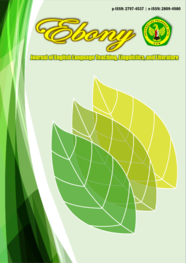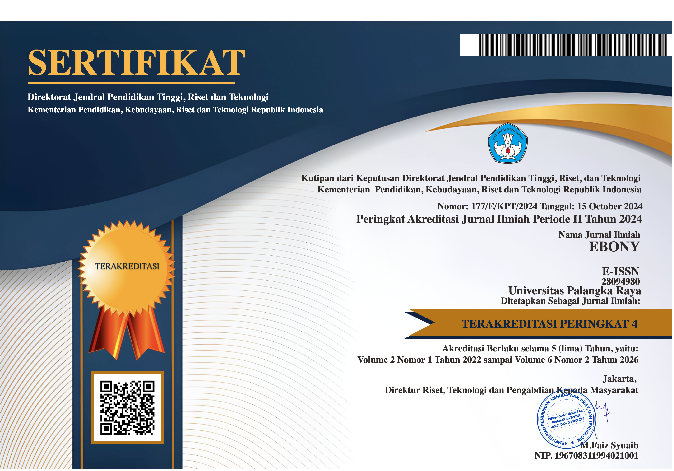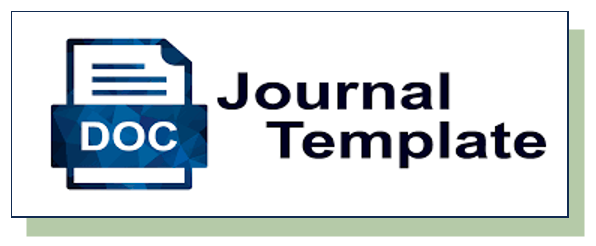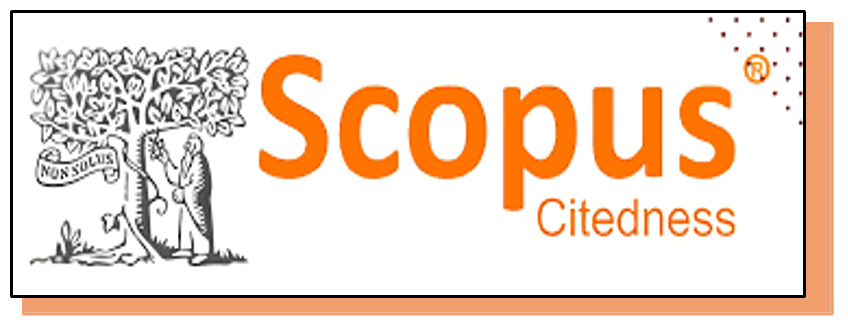Transformative Experience of Reading Digital Literature in Social Media
DOI:
https://doi.org/10.37304/ebony.v5i2.20201Keywords:
digital literature , social media, readingAbstract
Social media is inevitable part of culture and as the consequence, reading behaviour transforms. This study investigates how digital literature in social media is leveraged through Instagram Reels and TikTok videos, transforming the reading experience in English language acquisition. Employing a phenomenological qualitative methodology, data were gathered via in-depth interviews with three fourth-semester students who participated in the Digital Literature course. The thematic analysis of the data uncovers three primary findings: first, digital literature is favoured for its concise and familiar format that aligns with everyday experiences; second, the interpretation of texts is facilitated by themes and language styles that closely mirror the emotional realities of students; third, digital platforms create opportunities for self-expression, allowing students to experience freedom in writing, sharing, and reflecting on their own personal experiences. The findings of this study highlight that digital literature transcends being merely an alternative medium in literacy education; it embodies a humanistic practice that intertwines language, emotions, and existence. The findings suggest a need to rethink English teaching methods to be more flexible, inclusive, and focused on the emotional experiences of students.
Downloads
References
Agrawal, S. (2023). Twitterature: A New Digital Literary Genre. Evolutionary Studies in Imaginative Culture, 7(2). https://doi.org/10.56801/esic.v7.i2.6
Al-Jarf, R. (2022). Enhancing EFL Students’ Reading and Appreciation Skills with Mobile Fiction Apps. International Journal of Linguistics Studies, 2(2). https://doi.org/10.32996/ijls.2022.2.2.3
Arifah, A. Z., Mega, N. T., Putri, R. D., & Angelica, Y. (2021). Penggunaan Media Sosial Instagram Dalam Pembelajaran Bahasa, Sastra Dan Budaya Pada Era Digital. Seminar Nasional Pembelajaran Bahasa Dan Sastra (SELASAR). https://repository.um.ac.id/1181/
Audrin, C., & Audrin, B. (2022). Key factors in digital literacy in learning and education: a systematic literature review using text mining. Education and Information Technologies, 27(6). https://doi.org/10.1007/s10639-021-10832-5
Bados, E. (2023). Videopoetry and social networks. An introduction to the problems of the relationship between literature, subjectivity and digital devices. America Sin Nombre, 28. https://doi.org/10.14198/AMESN.22054
Canals-Botines, M., & Raluy Alo, A. (2023). Digital literature literacy (DLL) and literature digital reading (LDR) in european schools. techno Review. International Technology, Science and Society Review / Revista Internacional de Tecnología, Ciencia y Sociedad, 13(4). https://doi.org/10.37467/revtechno.v13.4810
Chinita, T. N. (2020). Variasi Bahasa Penggunaan Media Sosial Instagram Siswa SMA dan Implikasinya dalam Pembelajaran Bahasa dan Sastra Indonesia. Bachelor’s Thesis, Jakarta: FITK UIN Syarif Hidayatullah Jakarta, 1113013000006. http://repository.uinjkt.ac.id/dspace/handle/123456789/53150
Haddock, A., Ward, N., Yu, R., & O’Dea, N. (2022). Positive Effects of Digital Technology Use by Adolescents: A Scoping Review of the Literature. In International Journal of Environmental Research and Public Health (Vol. 19, Issue 21). https://doi.org/10.3390/ijerph192114009
Hakim, A. R., Widayati, A., Wibawa, E. A., & Septiana, Y. (2023). The effectiveness of digital literature-based learning video on improving student’s digital literature skill. Jurnal Pendidikan Ilmu Sosial, 33(1). https://doi.org/10.23917/jpis.v33i1.21782
Handayani, R. D., Syafei, M. S., & Perwikasih Utari, A. R. (2021). The perception on the use social media in learning english. Prominent, 4(1). https://doi.org/10.24176/pro.v4i1.5780
Handayani, S., Youlia, L., Febriani, R. B., & Syafryadin, S. (2020). The use of digital literature in teaching reading narrative text. Journal of English Teaching, Applied Linguistics and Literatures (JETALL), 3(2). https://doi.org/10.20527/jetall.v3i2.8445
Handayani, W., & San Fauziya, D. (2023). Cultivation of Digital Literacy Culture Through an Interest in Reading Literature 21st Century Life Skills. JLER (Journal of Language Education Research), 6(3). https://doi.org/10.22460/jler.v6i3.20275
Hietajärvi, L., Maksniemi, E., & Salmela-Aro, K. (2022). Digital Engagement and Academic Functioning: A Developmental-Contextual Approach. European Psychologist, 27(2). https://doi.org/10.1027/1016-9040/a000480
Jannah, R., & Wati, R. (2021). Kontribusi media siber terhadap keberadaan sastra religi di media sosial instagram. LITERASI: Jurnal Ilmiah Pendidikan Bahasa, Sastra Indonesia Dan Daerah, 11(2). https://doi.org/10.23969/literasi.v11i2.3460
Joseph, V., & Khan, N. (2020). Digital Literacy Tools to Enhance English Reading and Writing Skills: A Detailed Literature Review. Global Language Review, V(III). https://doi.org/10.31703/glr.2020(v-iii).03
Kenzhekozhayeva, А., & Mambetov, J. O. (2023). History of formation and development of the concept of digital literature. Keruen, 78(1). https://doi.org/10.53871/2078-8134.2023.1-08
Knoblauch, C. H. (1988). Rhetorical Constructions: Dialogue and Commitment. College English, 50(2). https://doi.org/10.2307/377638
Lütge, C., Merse, T., Owczarek, C., & Stannard, M. (2019). Crossovers: Digitalization and literature in foreign language education. Studies in Second Language Learning and Teaching, 9(3). https://doi.org/10.14746/ssllt.2019.9.3.5
M. Busairi. (2022). Gaya bahasa sindiran dalam instagram komik kita: kajian stilistika. MABASAN, 16(2). https://doi.org/10.26499/mab.v16i2.526
McGovern, J. (1993). Understanding poetry. Language Awareness, 2(1). https://doi.org/10.1080/09658416.1993.9959816
Moroney, E., Lee, S. S., Ebbert, A. M., & Luthar, S. S. (2023). Digital media use frequency, online behaviors, and risk for negative mental health in adolescents in high-achieving schools. Clinical Child Psychology and Psychiatry, 28(1). https://doi.org/10.1177/13591045221108834
Mulyanto, A., Probowati, A. R., & Purnamasari, R. (2023). Analisis gaya bahasa sindiran dalam video tiktok rian fahardhi. Semantik, 12(2). https://doi.org/10.22460/semantik.v12i2.p141-160
Mustofa, A., & Lestari, L. A. (2023). Literary criticism in the digital age: addressing the problems and opportunities of digital literature in efl pedagogy. English Review: Journal of English Education, 11(1). https://doi.org/10.25134/erjee.v11i1.7137
Muthoharoh, M., & Prastyaningsih, H. (2020). Melestarikan budaya literasi karya sastra melalui literasi digital di era milenial. Lingua Rima: Jurnal Pendidikan Bahasa Dan Sastra Indonesia, 9(1). https://doi.org/10.31000/lgrm.v9i1.2404
Nurfaidah, R. (2021). Refresentasi Perempuan dalam Satra dan Media Sosial: Sebuah Perbandingan. Sirok Bastra, 9(2).
Paliath, G., & Evangeline, M. (2022). E-Learning and Social Media for ELT — Teachers’ Perspective. Journal of Language Teaching and Research, 13(6). https://doi.org/10.17507/jltr.1306.25
Phan, V. H., & Ho-Trinh, Q. T. (2023). A Cognitive Investigation into the Love-life Relationship Expressed in Poetry. Metaphor and Symbol, 38(2). https://doi.org/10.1080/10926488.2022.2058398
Purvis, A. J., Rodger, H. M., & Beckingham, S. (2020). Experiences and perspectives of social media in learning and teaching in higher education. International Journal of Educational Research Open, 1. https://doi.org/10.1016/j.ijedro.2020.100018
Ribeiro, A. C. (2013). Heavenly hurt: The joy and value of sad poetry. In Suffering Art Gladly: The Paradox of Negative Emotion in Art. https://doi.org/10.1057/9781137313713
Schwabe, A., Brandl, L., Boomgaarden, H. G., & Stocker, G. (2021). Experiencing literature on the e-reader: the effects of reading narrative texts on screen. Journal of Research in Reading, 44(2). https://doi.org/10.1111/1467-9817.12337
Selfa Sastre, M., & Falguera Garcia, E. (2022). From Text on Paper to Digital Poetry: Creativity and Digital Literary Reading Practices in Initial Teacher Education. Frontiers in Psychology, 13. https://doi.org/10.3389/fpsyg.2022.882898
Septiani, N.A., Ihsan, N.M., Abdillah, F.R.R., & Pratiwi, D. (2022). Sosialisasi Sastra Digital dan Pelatihan Penulisan Sastra bagi Anak-anak dan Remaja di Karanglo, Argomulyo, Sedayu, Bantul. Jurnal Anugerah, 4(2). https://doi.org/10.31629/anugerah.v4i2.4380
Talavira, N. M. (2019). Verbalization of love in modern English poetry: constructional approach. Literature and Culture of Polissya, 95(12f). https://doi.org/10.31654/2520-6966-2019-12f-95-142-149
Theinová, D. (2020). Poetry of Silence: Rhetorical Concealment and the Possibility of Speech. In New Directions in Irish and Irish American Literature. https://doi.org/10.1007/978-3-030-55954-0_5
Turner, P., & Turner, S. (2013). Emotional and aesthetic attachment to digital artefacts. Cognition, Technology and Work, 15(4). https://doi.org/10.1007/s10111-012-0231-x
Viires, P. (2017). On the definition and periodisation of digital literature. Philologia Estonica Tallinnensis, 2. https://doi.org/10.22601/pet.2017.02.08
Vittoria, P. (2018). Critical education in paulo freire: Educational action for social transformation. Encyclopaideia, 22(51). https://doi.org/10.6092/issn.1825-8670/8459
Waltz, D. L. (1975). On understanding poetry. Proceedings of the 1975 Workshop on Theoretical Issues in Natural Language Processing, TINLAP 1975. https://doi.org/10.3115/980190.980206
Wendorff, A. (2020). The “narrative turn” in literature. observations on digital works. Art Inquiry, 22. https://doi.org/10.26485/AI/2020/22/10
Downloads
Published
How to Cite
Issue
Section
License
Copyright (c) 2025 Nukmatus Syahria, Rahmat Setiawan, Ferra Dian Andanty, Lubna Iasya, Syarif Adhim

This work is licensed under a Creative Commons Attribution 4.0 International License.











